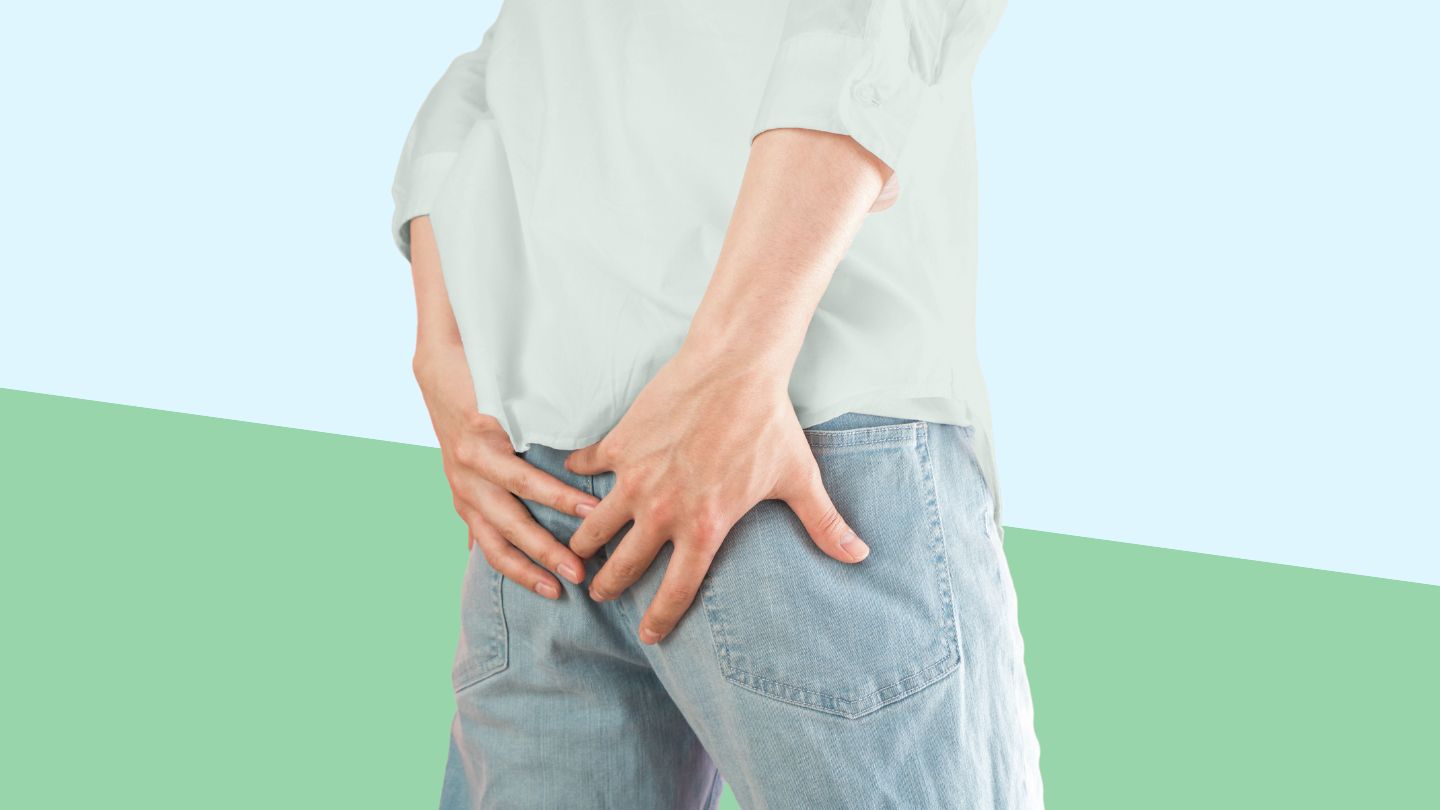Anal fissures are cracks or tears in the thin tissue that lines the anus. These tears can happen when the anus experiences stretching or trauma, such as when a person strains to pass a bowel movement, and they can cause bleeding and pain. Most anal fissures heal on their own with self-care, but chronic anal fissures may need further treatment.e60dc2a1-f33c-4a05-9b50-8e3e8e59762941b75dee-7d40-4125-aa0a-e30f5d2f79cf
Types of Anal Fissures Types Anal fissures are categorized by healing time and location on the anus.e60dc2a1-f33c-4a05-9b50-8e3e8e5976291ac41d40-2f38-46a1-bb5f-a17bf09eab01 Healing Time: Acute vs. Chronic Anal Fissures Acute anal fissures last less than six weeks. Chronic anal fissures last more than six weeks. Location: Primary vs. Secondary Anal Fissures Primary anal fissures are the most common, and they occur at the back or front of the anal opening. Secondary anal fissures are those that happen in any other location in the anus other than a primary fissure, such as the side of the anal opening.
Signs and Symptoms of Anal Fissures Symptoms Signs and symptoms of anal fissures typically involve bleeding and pain in and around the anus. Symptoms may include:e60dc2a1-f33c-4a05-9b50-8e3e8e5976299a304c09-8c1b-4aa1-8bbe-205a20898713e60dc2a1-f33c-4a05-9b50-8e3e8e597629cf3f251b-356a-45b3-aeaa-58985beae7d5 Sharp pain while passing a bowel movement Burning or itching during bowel movements Radiating pain in the buttocks, upper thighs, or lower back Lingering anal pain after passing a bowel movement (up to several hours) Bright red bleeding in your stool or on toilet paper A visible tear in the skin of the anus A small lump near the fissure Anal muscle spasms
Causes and Risk Factors of Anal Fissures Causes Any kind of anal trauma, like stretching or straining, can cause anal fissures. Certain factors may put you at higher risk. Causes of anal fissures include:e60dc2a1-f33c-4a05-9b50-8e3e8e597629398b1ff2-f578-4f7a-812b-116c006dbdbee60dc2a1-f33c-4a05-9b50-8e3e8e5976296a3fb7c4-0a67-41b6-886e-55b55dbb4a01 Constipation Straining while passing a bowel movement Passing large, hard stools Chronic diarrhea Anal intercourse or penetration Childbirth Your age can increase your risk of anal fissures: They happen most often in infants and middle-aged adults. Other factors can also increase your risk, including:e60dc2a1-f33c-4a05-9b50-8e3e8e59762989ddb5c8-680e-4eef-bb2d-90642fa3dca7e60dc2a1-f33c-4a05-9b50-8e3e8e5976297785a815-8edb-46ff-b76c-92c474bcc46ae60dc2a1-f33c-4a05-9b50-8e3e8e597629db376b6a-b2aa-4b34-9f01-97ef40723d2d Inflammatory bowel disease , such as Crohn’s disease Anal cancer HIV/AIDS Pregnancy Tuberculosis Obstructed defecation syndrome (a disorder that makes it difficult to pass bowel movements) Prior surgery in the area Sexually transmitted infections (STIs) Diaper rash Not eating enough fiber Once the thin tissue of the anus tears, it can be difficult for it to heal. Muscle spasms may pull the wound open and make it easier to tear further with your next bowel movement.e60dc2a1-f33c-4a05-9b50-8e3e8e597629cd0f7bb2-9ead-4d42-8d55-b909ac061999
How Are Anal Fissures Diagnosed? Diagnosis A healthcare provider typically diagnoses anal fissures with a gentle exam. Acute fissures may look like a paper cut, but a chronic fissure may appear deeper and have growths around it.e60dc2a1-f33c-4a05-9b50-8e3e8e597629a6d4deb3-c245-44b8-bf11-031cbd2a039ae60dc2a1-f33c-4a05-9b50-8e3e8e597629702b91ff-08fc-4927-89c9-dfd7b0dd4086 Your provider will also ask about your symptoms and medical history. During your exam, they will try to find the fissure to see how deep it goes, if it’s not too painful for you.e60dc2a1-f33c-4a05-9b50-8e3e8e597629d60241a3-8661-4ca2-b3b9-6623e2213b6be60dc2a1-f33c-4a05-9b50-8e3e8e5976293e09acac-af21-44d2-b967-b0cffb353c5e Depending on the location of the anal fissure and other risk factors (such as age), you may need some other tests to rule out underlying conditions like Crohn’s disease. In these tests, a thin tube with a camera on the end is inserted into your anus. The tests differ based on what part of your gastrointestinal (GI) tract your provider wants to see with the camera:e60dc2a1-f33c-4a05-9b50-8e3e8e597629146ee244-54e7-4cbb-8bf8-38fa0030191be60dc2a1-f33c-4a05-9b50-8e3e8e597629ff995427-b632-4c73-b73f-02a068e57dab Anoscopy This office-based test helps a provider view the rectum and internal anus. Flexible Sigmoidoscopy Flexible sigmoidoscopy allows a provider to see the bottom portion of the colon (large intestine). Colonoscopy This test helps a provider view the entire colon. A colonoscopy typically requires a full prep and is performed under anesthesia. During these tests, your provider may remove a small piece of tissue for further testing in a lab. This is known as a biopsy .e60dc2a1-f33c-4a05-9b50-8e3e8e5976298f257c6f-15af-401e-a746-319dc148d6dd For very painful anal fissures and those that keep coming back, you may need an examination under anesthesia.e60dc2a1-f33c-4a05-9b50-8e3e8e597629de09b4e7-c16b-421d-84bc-cddac0d7b09a
Treatment and Medication Options for Anal Fissures Treatment The majority of anal fissures heal on their own without treatment.e60dc2a1-f33c-4a05-9b50-8e3e8e597629cead200c-9888-4af8-bba9-0b9fba08872e For anal fissures that need treatment, the primary goals are healing and preventing them from happening again (recurrence).e60dc2a1-f33c-4a05-9b50-8e3e8e59762948c9d7e7-11a3-42a6-bbe5-e70c3f95c87a Initial treatments focus on pain relief, softening the stool, and frequent cleaning. If these aren’t effective enough, your provider may recommend topical medications to help with pain and encourage faster healing. Occasionally, surgery may be needed to repair a chronic fissure.e60dc2a1-f33c-4a05-9b50-8e3e8e597629027aa145-0e7d-434a-8263-073857514e1be60dc2a1-f33c-4a05-9b50-8e3e8e59762944ac5e10-bc90-4cb8-81e8-1a7cf32d7133 Self-Care Self-care strategies include frequent cleaning and creating the best possible environment for healing. With these home treatments, most anal fissures can heal within a few weeks:e60dc2a1-f33c-4a05-9b50-8e3e8e597629b362c08c-0b08-459f-954c-34934032b241e60dc2a1-f33c-4a05-9b50-8e3e8e597629d50e9cab-af6e-4448-85df-0417b3e1de99 Soak your anus in warm water several times a day for 10 to 20 minutes each time, either in a bath or a smaller container you can sit in. The water should only cover the buttocks and hips. This is sometimes called a sitz bath. Try to do this after bowel movements. For infants, change their diaper often, washing the area gently with each change. After passing a bowel movement, use a bidet or clean yourself thoroughly in the shower. Medication Options If home remedies don’t heal an anal fissure, you may need a prescription or over-the-counter cream or medication. Topical Creams and Gels These can increase blood flow to the tear, relax the anal muscles, ease pain, and speed up healing. They include:e60dc2a1-f33c-4a05-9b50-8e3e8e597629edf1e9d8-005e-4012-84b4-5e8e1cb5b31be60dc2a1-f33c-4a05-9b50-8e3e8e597629b7af246a-ec82-4b40-8f16-599b0bd83affe60dc2a1-f33c-4a05-9b50-8e3e8e5976293fa61bbc-5dc8-4253-80cd-e08b10a58ab9 Nitroglycerin (Rectiv) Topical nifedipine Lidocaine (Xylocaine) Petroleum jelly (Vaseline) Zinc oxide (Desitin) 1 percent hydrocortisone cream (Cortizone) Phenylephrine (Preparation H) Oral Blood Pressure Medicines Medications like calcium channel blockers can relax anal muscles, but they are typically only used if topical treatments haven’t worked. The most common options are diltiazem (Cardizem) and nifedipine (Procardia).e60dc2a1-f33c-4a05-9b50-8e3e8e59762971f9f7e0-dc5b-4c19-a1fc-8b83d23e2899 Injection With OnabotulinumtoxinA (Botox) This can relax anal muscle spasms for pain relief and faster healing.e60dc2a1-f33c-4a05-9b50-8e3e8e597629c16614e3-437c-48e9-93bc-dc0b79c226cae60dc2a1-f33c-4a05-9b50-8e3e8e597629c0a82b38-1daf-466f-8a0f-98696cbe89fe Laxatives and Stool Softeners These can prevent further tearing if constipation is the main cause of your fissure. Your provider may recommend one of these options:e60dc2a1-f33c-4a05-9b50-8e3e8e5976295ae944c0-0a62-4295-a642-0462ff671f90e60dc2a1-f33c-4a05-9b50-8e3e8e597629bed138a8-ec19-40aa-b30d-de86572cc6c8 Psyllium (Metamucil) Magnesium hydroxide (milk of magnesia) Polyethylene glycol (MiraLax) Docusate sodium (Colace) Mineral oil Magnesium citrate (Citroma) Before you try any over-the-counter medications to treat your anal fissures, be sure to tell your healthcare provider first. Surgery For chronic anal fissures that don’t heal with other treatments, surgery may be needed. The surgical procedure used to treat anal fissures is called a lateral internal sphincterotomy. This surgery comes with a slight risk of causing incontinence (inability to hold in your stool), but it also has a success rate of 90 percent.e60dc2a1-f33c-4a05-9b50-8e3e8e597629ec333172-7d7d-4f31-8e89-26b63355d431e60dc2a1-f33c-4a05-9b50-8e3e8e597629003c8def-b7d3-444e-9b51-16c2478f4524
Prevention of Anal Fissures Prevention Because anal fissures often happen after injury or trauma to the area from large, hard bowel movements, you may be able to prevent them by making certain lifestyle changes.e60dc2a1-f33c-4a05-9b50-8e3e8e597629f0829095-bcc9-44ec-8cae-90ceb7197690
Lifestyle Changes for Anal Fissures Lifestyle Changes As mentioned, certain lifestyle changes may help you prevent anal fissures. Make Dietary Changes Add more high-fiber foods to your diet, such as grains and fresh fruits and vegetables, to prevent constipation.e60dc2a1-f33c-4a05-9b50-8e3e8e59762932a5cd85-e16d-4aaa-8895-5ffdead09db2 Eating 25 to 35 grams of fiber per day can help keep your stools soft.e60dc2a1-f33c-4a05-9b50-8e3e8e5976293236c1e9-0ef4-4474-882a-fd208fc51894 Drinking enough fluid every day can also soften stools and help you avoid having to strain during bowel movements.e60dc2a1-f33c-4a05-9b50-8e3e8e597629361992a0-1265-4c4f-9fac-0665256bc7ce Experts recommend that men drink 15.5 cups of water per day and women drink 11.5 cups. If you’d rather drink other fluids, steer clear of those with high sugar or caffeine content.e60dc2a1-f33c-4a05-9b50-8e3e8e5976297fe1d7e7-1d81-4cf1-85e0-e1704494b04d Exercise Regularly When you exercise , the movement in your core stimulates your colon and can help prevent constipation. If the muscles around your GI tract are weak, they won’t be able to help you pass bowel movements very well. Regular exercise can keep those muscles strong.e60dc2a1-f33c-4a05-9b50-8e3e8e597629123cea2e-9dcb-49a7-b8e4-3a86c333c0f5e60dc2a1-f33c-4a05-9b50-8e3e8e597629c77db5b7-8f8e-4840-903a-872ba95972f7 It is recommended that most adults to get 150 minutes of exercise each week, which could translate to 30 minutes a day, five days a week.e60dc2a1-f33c-4a05-9b50-8e3e8e597629d8ae5b3a-2693-471c-8fdd-88b0795fa136 Exercise for bowel health doesn’t have to be intense to be effective. A daily 30-minute walk or some yoga , for example, can be enough to keep things moving in your gut.e60dc2a1-f33c-4a05-9b50-8e3e8e597629d63f26cf-26f3-46a3-955e-231c84ab4233 Treat Chronic Conditions If you have a chronic health condition that puts you at higher risk of anal fissures, such as Crohn’s disease or STIs, it’s important to follow your treatment plan. If your condition is well-managed, you’ll be less likely to experience anal fissures.e60dc2a1-f33c-4a05-9b50-8e3e8e597629f03dfc4f-05fd-42dd-ad0d-dae0aef2bd24
How Long Do Anal Fissures Last? Prognosis and Outlook Acute anal fissures often heal quickly, usually within a few days or weeks. But about 40 percent of acute anal fissures progress to chronic fissures, which can take another 6 to 12 weeks to heal.e60dc2a1-f33c-4a05-9b50-8e3e8e5976296bcca2d9-eee0-4d7f-941e-136bce66ff05e60dc2a1-f33c-4a05-9b50-8e3e8e597629abb73f99-1f70-40a7-bf56-a6070c8eb46a
Complications of Anal Fissures Complications Rarely, people experience complications with anal fissures, like:e60dc2a1-f33c-4a05-9b50-8e3e8e597629280be12e-4541-4094-b57f-fc79518b7fa0e60dc2a1-f33c-4a05-9b50-8e3e8e5976299b34ef8a-f76c-447a-8ca0-df23c047cf3fe60dc2a1-f33c-4a05-9b50-8e3e8e59762973445610-762c-4aa0-b061-5aec2e393b6d Slow or incomplete healing Anal muscle tension Anal spasms Repeated fissures Tearing that extends to anal muscles Severe constipation and fecal impaction Anal narrowing (stenosis) Anal fistula (tunnel from the inside of the anus to the outer skin) Fecal incontinence Infection The best way to avoid these complications is by following your treatment plan and telling your provider about any new symptoms you’re having.
Research and Statistics: Who Has Anal Fissures? Research and Statistics Many people experience anal fissures. About 250,000 of them are diagnosed every year in the United States. Anal fissures happen most often in infants and pregnant women, and about 50 percent of them occur in people younger than 40. Both men and women are equally affected by anal fissures.e60dc2a1-f33c-4a05-9b50-8e3e8e59762935df74ad-6ba9-4d1f-af70-7139df81053ae60dc2a1-f33c-4a05-9b50-8e3e8e59762979388795-650d-4264-979f-206c69e26e5f
Related Conditions Related Conditions Some conditions have similar symptoms to anal fissures, including:e60dc2a1-f33c-4a05-9b50-8e3e8e59762948d4e042-6f4a-4dff-8838-aee7647c7425 Hemorrhoids Perianal abscess (pocket of infection) Anal fistulas Certain STIs Inflammatory bowel disease Tuberculosis
The Takeaway An anal fissure is a small tear in the thin lining of the anus, which causes symptoms like sharp pain and bleeding during and after passing a bowel movement. Anal fissures are caused by trauma to the anus, typically from straining to pass large or hard bowel movements. You can treat anal fissures with home remedies to help with the pain and spasms, as well as dietary changes to reduce constipation, but sometimes medications or surgery are needed. If you experience symptoms of an anal fissure, let your healthcare provider know. They can help you understand what’s going on and what you can do to recover.
Resources We Trust Mayo Clinic: Anal FissureCleveland Clinic: Anal FissuresAmerican Society of Colon & Rectal Surgeons: Anal FissureJohns Hopkins Medicine: Anal FissuresCedars-Sinai: Anal Fissures
Read the full article here
Leave a comment



